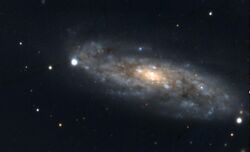Astronomy:NGC 3511
| NGC 3511 | |
|---|---|
 NGC 3511 by PanSTARRS | |
| Observation data (J2000 epoch) | |
| Constellation | Crater |
| Right ascension | 11h 03m 23.8s[1] |
| Declination | −23° 05′ 12″[1] |
| Redshift | 0.003699 ± 0.000010 [1] |
| Helio radial velocity | 1,109 ± 3 km/s[1] |
| Distance | 41.5 ± 6.4 Mly (12.7 ± 2.0 Mpc)[1] |
| Apparent magnitude (V) | 10.8 [2] |
| Characteristics | |
| Type | SAB(s)c [1] |
| Apparent size (V) | 5.8′ × 2.0′ |
| Notable features | Extended HIPASS source[1] |
| Other designations | |
| UGCA 223, ESO 502- G013, AM 1100-224, MCG -04-26-020, PGC 33385[1] | |
NGC 3511 is an intermediate spiral galaxy located in the constellation Crater. It is located at a distance of circa 45 million light years from Earth, which, given its apparent dimensions, means that NGC 3511 is about 70,000 light years across. It was discovered by William Herschel on December 21, 1786.[3] It lies two degrees west of Beta Crateris.[4]
NGC 3511 features two very diffuse, thick, and patchy spiral arms that emanate from the bulge, while there are also other spiral arm fragments. Dark dust lanes can be seen across the spiral pattern. The bulge appears elliptical and is weak.[5] The galaxy is seen at a high inclination, estimated to be 70°.[6] In the centre of the galaxy lies a supermassive black hole, whose mass is estimated to be 106.46 ± 0.33 (1.3 - 6.2 million) M☉, based on the pitch angle of the spiral arms.[7] The galaxy had been classified as a type 1 Seyfert galaxy,[8] however it features only narrow emission lines, and has been reclassified as a HII region galaxy.[9] The Infrared Spectrograph (IRS) on the Spitzer Space Telescope has detected polycyclic aromatic hydrocarbon (PAH) emission.[10]
NGC 3511 forms a pair with NGC 3513, which lies 10.5 arcminutes away from NGC 3511.[11] The two galaxies form a small group, known as the NGC 3511 group, which also includes the galaxy ESO 502-024.[12]
See also
- NGC 4088 and NGC 2427 - two similar spiral galaxies
Gallery
NGC 3511 by GALEX
Pan-STARRS image of NGC 3511
legacy surveys image of NGC 3511
References
- ↑ 1.0 1.1 1.2 1.3 1.4 1.5 1.6 1.7 "NASA/IPAC Extragalactic Database". Results for NGC 3511. http://ned.ipac.caltech.edu/cgi-bin/nph-objsearch?objname=NGC+3511.
- ↑ "Revised NGC Data for NGC 3511". http://spider.seds.org/ngc/revngcic.cgi?NGC3511.
- ↑ Seligman, Courtney. "NGC 3511". https://cseligman.com/text/atlas/ngc35.htm#3511.
- ↑ Bakich, Michael E. (2010) (in en). 1,001 Celestial Wonders to See Before You Die: The Best Sky Objects for Star Gazers. Springer Science & Business Media. p. 79. ISBN 9781441917775. https://books.google.com/books?id=qEhpS7d5ZdAC&pg=PA79.
- ↑ Eskridge, Paul B.; Frogel, Jay A.; Pogge, Richard W.; Quillen, Alice C.; Berlind, Andreas A.; Davies, Roger L.; DePoy, D. L.; Gilbert, Karoline M. et al. (November 2002). "Near-Infrared and Optical Morphology of Spiral Galaxies". The Astrophysical Journal Supplement Series 143 (1): 73–111. doi:10.1086/342340. Bibcode: 2002ApJS..143...73E.
- ↑ Thean, A.; Pedlar, A.; Kukula, M. J.; Baum, S. A.; O'Dea, C. P. (1 August 2001). "High-resolution radio observations of Seyfert galaxies in the extended 12- m sample - II. The properties of compact radio components". Monthly Notices of the Royal Astronomical Society 325 (2): 737–760. doi:10.1046/j.1365-8711.2001.04485.x. Bibcode: 2001MNRAS.325..737T.
- ↑ Davis, Benjamin L.; Berrier, Joel C.; Johns, Lucas; Shields, Douglas W.; Hartley, Matthew T.; Kennefick, Daniel; Kennefick, Julia; Seigar, Marc S. et al. (20 June 2014). "The Black Hole Mass Function Derived from Local Spiral Galaxies". The Astrophysical Journal 789 (2): 124. doi:10.1088/0004-637X/789/2/124. Bibcode: 2014ApJ...789..124D.
- ↑ Deo, Rajesh P.; Richards, Gordon T.; Crenshaw, D. M.; Kraemer, S. B. (1 November 2009). "The Mid-Infrared Continua of Seyfert Galaxies". The Astrophysical Journal 705 (1): 14–31. doi:10.1088/0004-637X/705/1/14. Bibcode: 2009ApJ...705...14D.
- ↑ Tommasin, Silvia; Spinoglio, Luigi; Malkan, Matthew A.; Fazio, Giovanni (1 February 2010). "Spitzer-IRS High-Resolution Spectroscopy of the 12 μm Seyfert Galaxies. II. Results for the Complete Data Set". The Astrophysical Journal 709 (2): 1257–1283. doi:10.1088/0004-637X/709/2/1257. Bibcode: 2010ApJ...709.1257T.
- ↑ Gallimore, J. F.; Yzaguirre, A.; Jakoboski, J.; Stevenosky, M. J.; Axon, D. J.; Baum, S. A.; Buchanan, C. L.; Elitzur, M. et al. (1 March 2010). "Infrared Spectral Energy Distributions of Seyfert Galaxies: Spitzer Space Telescope Observations of the 12 μm Sample of Active Galaxies". The Astrophysical Journal Supplement Series 187 (1): 172–211. doi:10.1088/0067-0049/187/1/172. Bibcode: 2010ApJS..187..172G.
- ↑ Sandage, A., Bedke, J. (1994), The Carnegie Atlas of Galaxies. Volume I, Carnegie Institution of Washington
- ↑ Makarov, Dmitry; Karachentsev, Igor (21 April 2011). "Galaxy groups and clouds in the local (z~ 0.01) Universe". Monthly Notices of the Royal Astronomical Society 412 (4): 2498–2520. doi:10.1111/j.1365-2966.2010.18071.x. Bibcode: 2011MNRAS.412.2498M. http://www.sao.ru/hq/dim/groups/galaxies.dat. Retrieved 18 January 2019.
External links
- NGC 3511 on WikiSky: DSS2, SDSS, GALEX, IRAS, Hydrogen α, X-Ray, Astrophoto, Sky Map, Articles and images
- NGC 3511 on SIMBAD
 |




